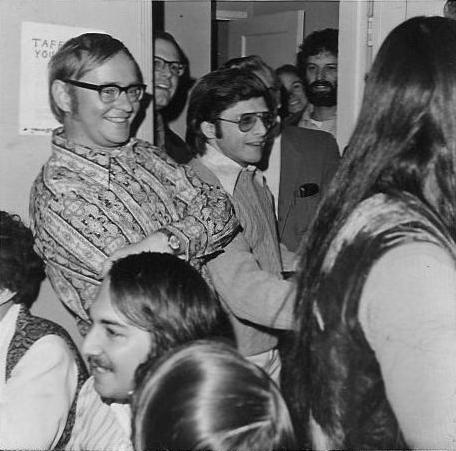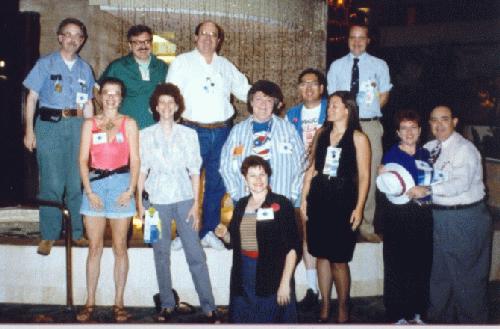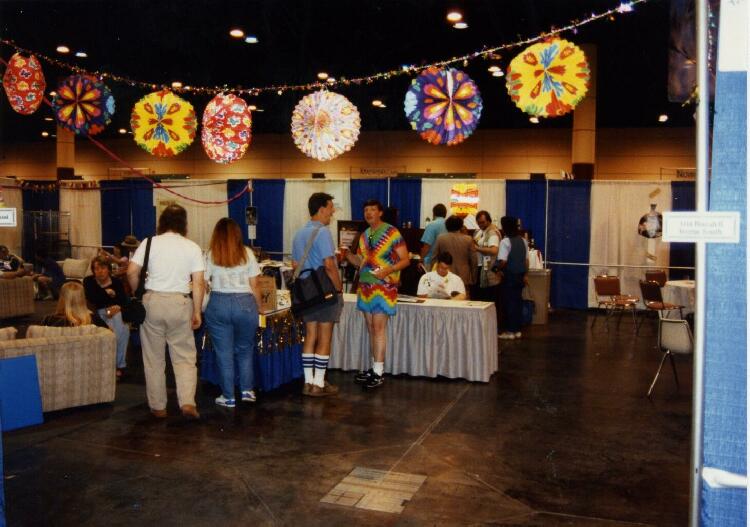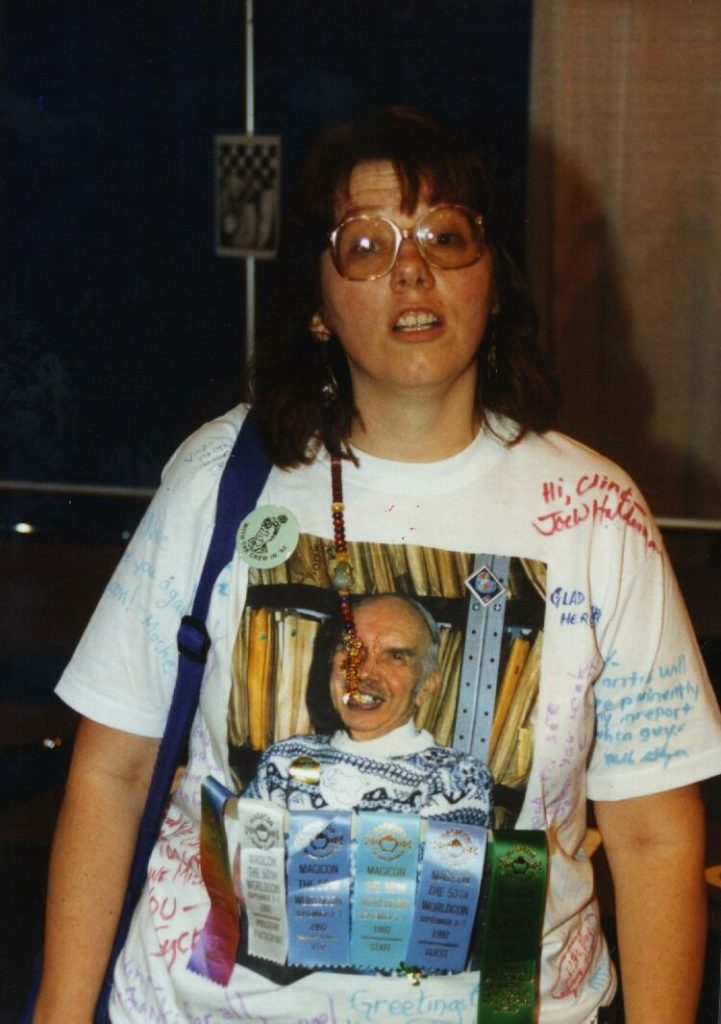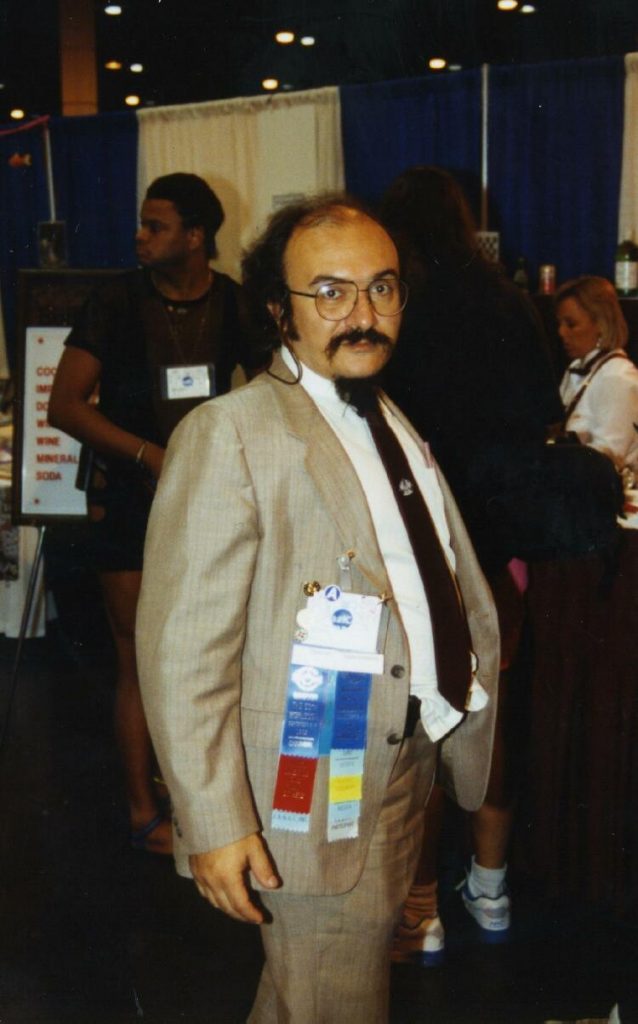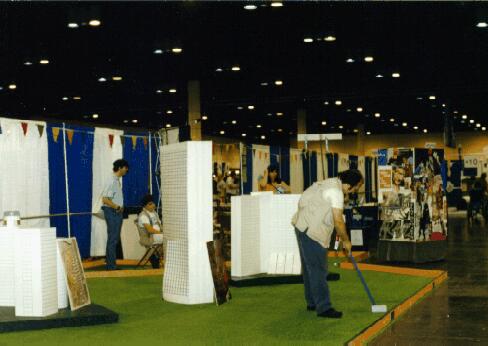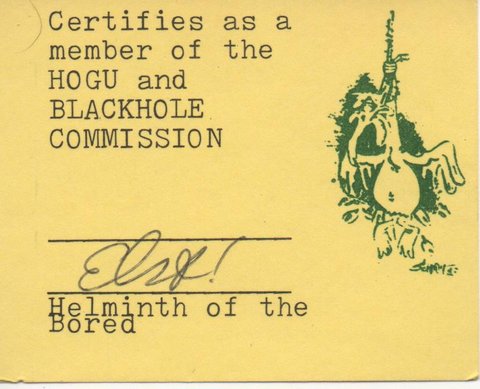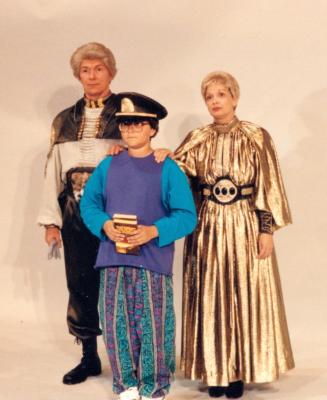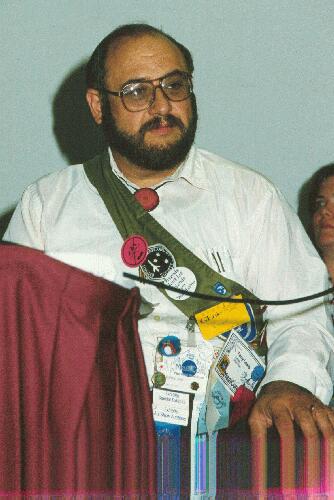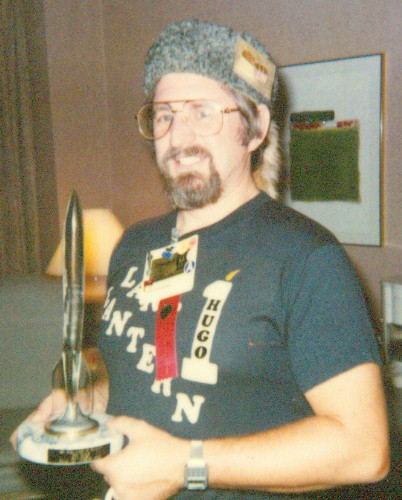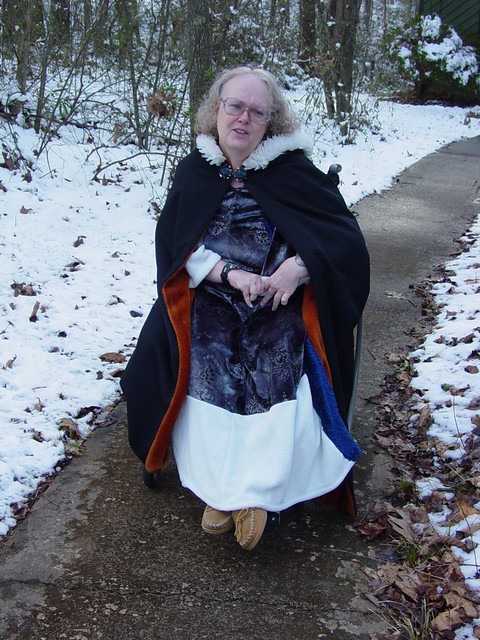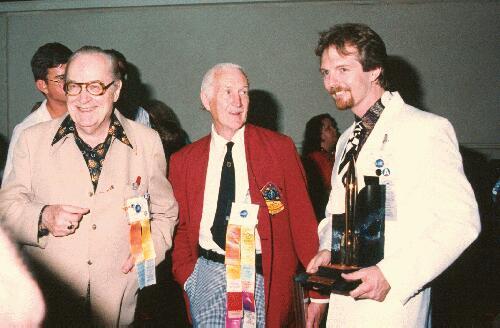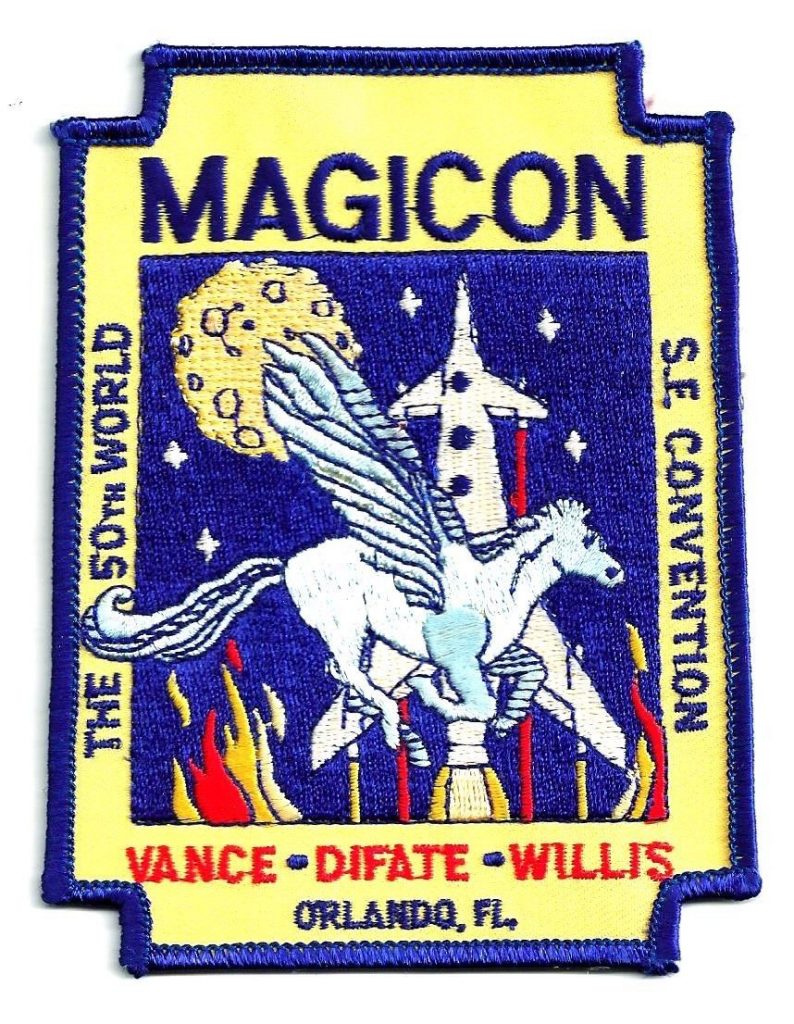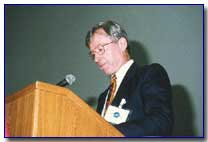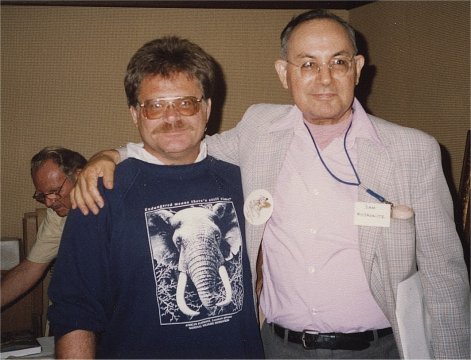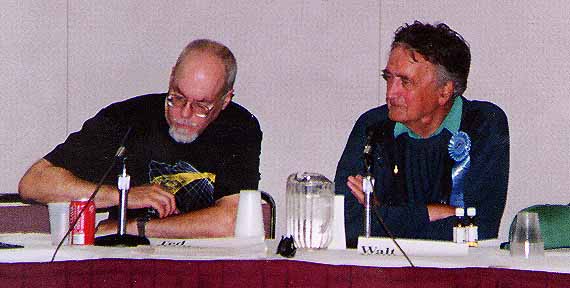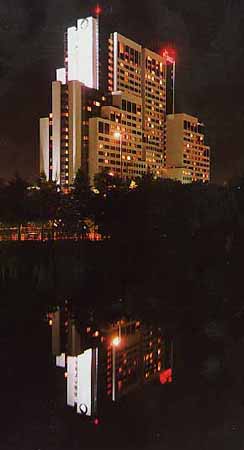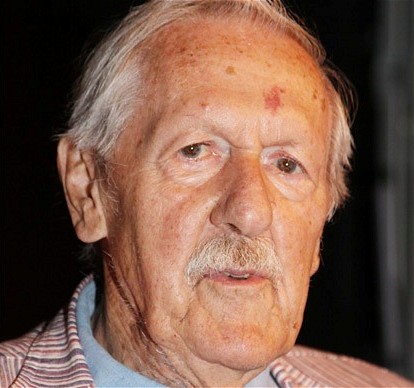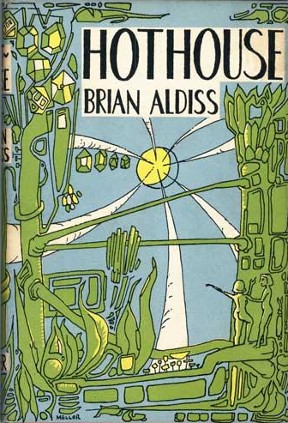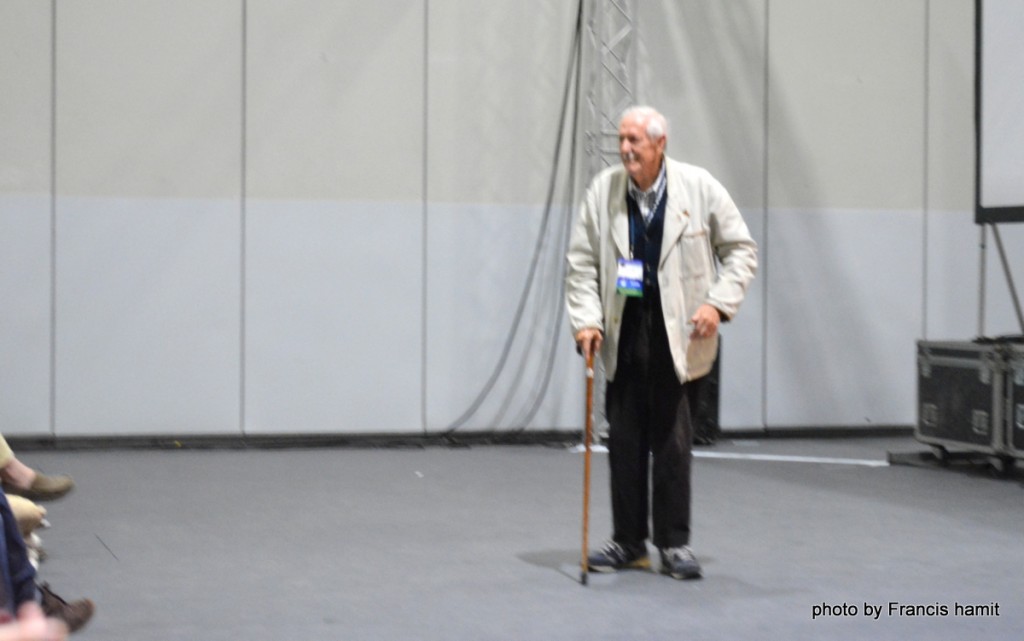
The Orange County Civic and Convention Center sign announcing MagiCon. Behind is a view of the MagiCon headquarters hotel, The Peabody. Photo by Carol Porter
Introduction: Twenty-five years ago today Magicon began in Orlando, Florida. A great con, and I thought it would be fun to reprint the report I ran in File 770. Here is the first daily installment.
The Worldcon was held in the Orange County Convention and Civic Center, The Peabody Hotel, and The Clarion Hotel.
Report by Mike Glyer: A short monorail ride delivered airport passengers to Orlando’s airport baggage claim where they boarded the shuttle bus to International Drive, a trip they’d complete without seeing anything developers hadn’t tamed to resemble a well-manicured golf course. Hi-tech, planned, smooth, everything conspired to achieve an illusion that the airport terminal gate was the entrance to Disneyworld. – Look out! Who’s that in the road…??!
Filksingers Lee and Barry Gold and many others discovered it could be worth their lives jaywalking International Drive between the Peabody Hotel and the Orange County Civic and Convention Center. As my shuttle passed, they leaped from the curb, guitars in hand, and ran through a gap in traffic. Less adventuresome fen used a marked crosswalk and waited on the traffic light.
FACILITIES: Seen from the Clarion Hotel the Orange County Civic and Convention Center looked like a white riverboat. Three recessed cornices at the center of the building resembled a riverboat’s stepped-back decks, flanked on each side by blunt hallways ending in arched romanesque windows like paddlewheel housings.
Unlike convention facilities in wintry cities, many sections of the Orlando convention center were illuminated by natural daylight. The airy, open sense of natural space raised everyone’s spirit.

A night view of the Orange County Civic & Convention Center where most of the MagiCon activities took place. Photo by Carol Porter
REGISTRATION: Membership services opened Wednesday and followed the recent trend of registering nearly half the attending members (2,300) the night before the official opening. Final attendance figures were hard to come by. Interim reports in the daily newzine said by noon Saturday there were 5,423 members present, including 213 dailies and 395 full memberships bought at the door.
The con required members to show a photo ID to get their packets. And they were serious — they even carded Danny Siclari, the con chairman’s son. A good thing, too, because Danny went around the rest of the weekend offering Masquerade tickets and panicking people who failed to get the joke. Jay Kay Klein, who has an absolute phobia about being unrecognized, produced a photograph of himself standing with Robert Silverberg and Isaac Asimov and asked, “Will this do?”
The influx of at-the-door memberships put $40,000 in the coffers, allowing the committee to restore budget cuts made in July based on dire predictions. The Green Room ran out of coffee within two hours of opening, but new membership money allowed them to refill coffee as needed after Thursday.
That computerized registration software hadn’t been perfected was admitted to MagiCon officials only five days before the con. Vice-chair Becky Thomson dialed the Worldcon’s answer to 911, computer consultant Ross Pavlac, for an emergency assist. For devoting long hours on short notice to writing a program he was presented a “Magicon Hero” medal on closing day. The attention he got wearing the medal at Magicon was nothing compared to the fuss made over him by parking lot attendants and waiters at Disneyworld…
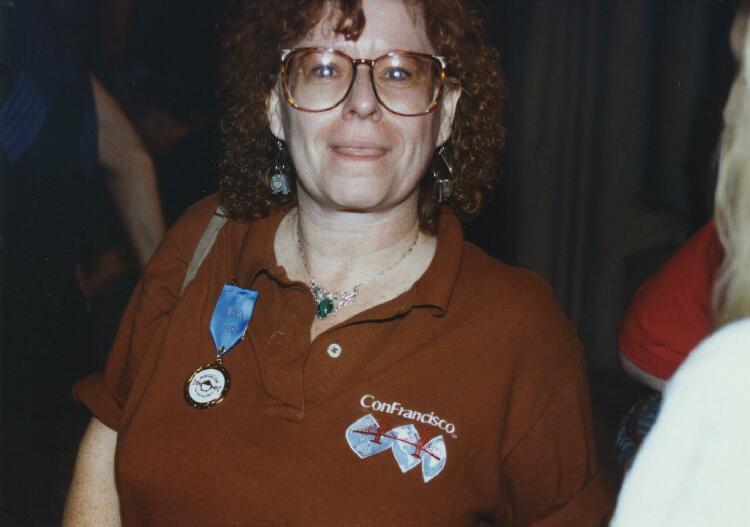
Crickett Fox wearing her MagiCon Hero medal.
Few such “saving throws” were needed by MagiCon because years in advance the central committee had done extensive recruitment of veteran convention runners and kept open communication with them with divisional APAs, e-mail and committee meetings at regionals. Money was at a premium but fans from all over the east coast (especially Boston) and England joined the core committee of Floridians and overcame resource problems with hard work.
OPENING CEREMONIES: Fans milling outside Hall A half an hour beyond the scheduled starting time for opening ceremonies because the dress rehearsal ran over were rewarded by the most excellent opening ceremonies of the 11 Worldcons I’ve attended.
The hall darkened, John Williams’ Olympic fanfare rang out, astronomical slides were projected and a voice in the rafters rumbled that we were at MagiCon, the 50th Worldcon.
“Thank you, Lord,” answered toastmaster Spider Robinson, stepping into a spotlight. His introduction dedicated the con to three “ghosts of honor”, Heinlein, Sturgeon and Asimov. He alluded to another great still with us, Clarke, while debunking the familiar Magicon motto: “Blending science and technology — as if there was a difference!”

Toastmaster Spider Robinson.
Blundering into Spider’s rap came wizard Richard Hill in a gaudy foil robe. Hill had little idea about science and even less about science fiction. Spider faded offstage and let the “voice from above” guide Hill through a retrospective of science fiction. Beginning with an avalanche of familiar definitions of the genre authored by Knight, Panshin and others, the voice mercifully changed tack and finished with a gentle, anecdotal review of the field’s history illustrated by images projected on three screens, or dramatized by other actors.
Like the audioanimatronic presidents down the road at Disneyworld, Verne and Wells appeared in period costume. From 50 feet away they looked an awful lot like Don Eastlake and Anthony Lewis (but weren’t.) Other live actors included First Fandomites in vintage sf costumes, such as 1939 Worldcon attendees Ackerman and Kyle; perhaps I should have recognized them all, but I didn’t.
Once the play had unfolded Spider Robinson returned to say, “I’d like to thank you all for coming — or however you’re reacting.” He extended his thanks to the father of modern science fiction, Hugo Gernsback, “who established a pay rate which is still in effect for many publications.”
Then convention chairman Joe Siclari brought out the honored guests, Jack and Norma Vance, Walt and Madeleine Willis, and Vincent Di Fate.
MAGICON CONCOURSE: A tradition, in fandom, is anything that’s been done once. When Noreascon 3 (1989) transformed its convention center’s wastelands into a thematic concourse of standing exhibits, lounges and bidder tables the fannish consciousness promptly grasped that was the way things ought to be done. Despite Boston’s successful experiment the next two Worldcons in Holland and Chicago returned to disjointed orthodoxy, leaving Magicon the first to recapture the spirit of Noreascon by creatively organizing the generic gray expanse of the OCCCC’s exhibit hall.

MagiCon Concourse. Photo by Mark Olson
Magicon enjoyed a great success by applying its people-power principle to overcome budget restraints. Just as Tom Sawyer dealt with whitewashing the picket fence, Magicon franchised its miniature golf holes to fan groups who paid for construction and staffed them because it looked like too much fun to miss!
Magicon ingeniously combined fan GoH Walt Willis’ imaginary world and favorite recreation into the thematic 10-hole Enchanted Duplicator Golf Course that snaked around the exhibit hall. Every hole was sponsored by a bidding committee, regional con or club who paid for materials and in many cases ran a table on site. The MCFI/Noreascon 4 bid took the hole shaped like the number 4. SCIFI/LA in ’96 had one in the shape of a question mark. The Glasgow in ’95 hole used scotch bottles to shape the playing area. Each hole featured a signboard quoting the passage from Enchanted Duplicator that served as its inspiration. The holes were constructed of astroturf with plywood curbs as boundaries. Homemade golf clubs (with wood blocks for heads), and plastic whiffle-golf-balls were stocked at every hole.

The entire miniature golf course was built inside the convention center. Each hole was themed to a scene from the Enchanted Duplicator, the most famous piece by Fan Guest of Honor Walter Willis (co-authored and illustrated by Bob Shaw.) Each hole was built by a different fannish club or worldcon bidder. The first hole was built and tested in the NESFA clubhouse, the last hole was built by the South Florida Science Fiction Society when they should have been preparing for Hurricane Andrew which hit South Florida the day after SFSFS constructed the Tower of Trufandom. Photo by Carol Porter
The miniature golf course proved more entertaining than its sponsors hoped, providing a great outlet for childrens’ energy and an entire new way for adults to think about normally drab convention centers. LA in ’96 gave away souvenir tokens to anyone making par (six strokes), and “Gummi Rats” to anyone who set or tied the hole record. A few of the younger kids became obsessed with the idea of breaking par. Michael Bienewicz-Velada (about 9 years old) and Len Wein (9 years old during Nixon’s “Checkers” speech) set a hole record at four. It fell to a young girl who played through a few dozen times and trimmed the record to three strokes.
Kids’ enthusiasm did little damage to the sturdy equipment provided by the Magicon Golf Hole Staff even when bludgeoning the ball through some of the trickier obstacles.


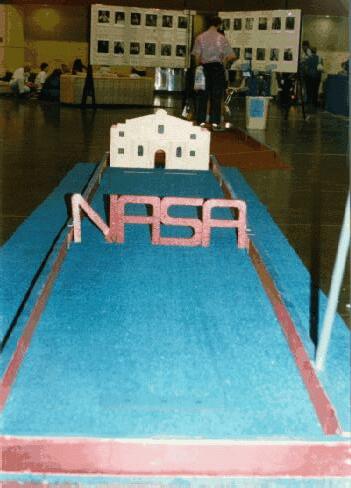
Hole #2, sponsored by the Fandom Association of Central Texas, which was bidding for San Antonio in ’97.
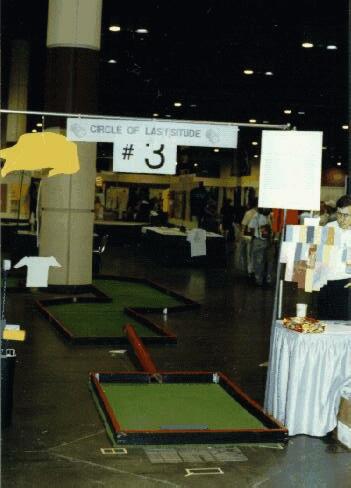
The Enchanted Duplicator Golf Course. Hole #3: The Circle of LASFSitude. As you can see the lasfsitude overtook the decoration of this hole. The most elaborate decoration was Bruce Pelz’ collection of MagiCon ribbons which you can see in progress hanging in the photo. LASFS member Drew Sanders is standing on the right.
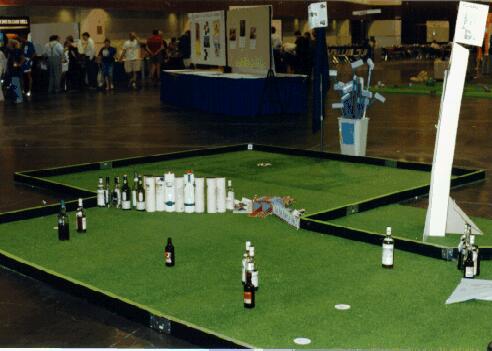
The hole created by the Glasgow in ’95 Worldcon bid for the MagiCon golf course. Obstacles were added daily — the whiskey bottles emptied by their bid parties.
Bruce Pelz and Gary Louie spent Thursday morning hanging the History of the Worldcon exhibits, a collection of myriad clippings, badges, pictures and membership badges. Nearby was a table full of irreplaceable Worldcon Program Books available to browse. This year there was an unprecdented theft from the exhibit: taken was an autographed copy of Robert Heinlein’s 1941 guest of honor speech. Pelz seemed resigned to the loss of the speech, handling it with black humor by pointing out although the text was signed by Heinlein and his spouse, Virginia had signed it, not Leslyn, Heinlein’s wife in 1941.

Bruce Pelz showing off the History of Worldcons exhibit. Photo by Mark Olson
A Glasgow bidder, in blue bid t-shirt and a plaid kilt, tried to have a conversation with Gary Louie. He was interrupted by Dutch fan Larry Van der Putte’s less-than-traditional greeting: walking up behind and lifting the fellow’s kilt to see what he was wearing underneath. The Scot replied to Larry’s greeting, “I’ll kill you later!”

Tim Illingworth and Marcia Kelly McCoy. Photo by Mark Olson.
A cyclopean eye against a far wall was the Sci-Fi Channel’s preview screen formed of 16 color television monitors alternately presenting mosaics of large single images or smaller redundant images.
The concourse was partitioned off from the rear half of the exhibit hall reserved for the Dealers’ Room and Art Show. At the Dealers’ Room entrance Dick Spelman sat behind a table, providing information, handling problems, and doling out the peach-colored ribbons which identified the sellers. On closer observation one discovered two versions of the same ribbon, one stamped “Dealer,” and the other, “Huckster.” Whichever title a seller used to refer to himself, Spelman was ready.
THE GENERALISSIMO OF BOLIVIA EFFECT: In fact, the worldcon tradition of creating a variety of colored ribbons achieved kaleidoscopic extremes at Magicon. Almost everyone enjoyed it as much as I did, but one of the exceptions was Rick Foss. At the end of a long evening of partying, Rick observed, “It’s been many years since I was at a con without seeing somebody wearing many ribbons to show how important he is passed out on a couch somewhere.”
Later at the gripe session someone claimed an unauthorized fan was giving directions during masquerade set-up and was obeyed because of his intimidating fruit salad of convention ribbons.
Most fans enjoy collecting all the badge paraphernalia they can. With a minimal investment of effort nearly anyone could get a “Jack Vance Festival of All Worlds”, “Site Selection Voter” or “Gopher” ribbon. Several clubs (NESFA, WSFA, BSFS) had their own powder-blue ribbons. The San Antonio in ’97 bid gave ribbons to presupporters. Boston in ’98 presupporters got an enamel pin. Hugo nominees received little gold-colored rocket pins (gold, because it was the 50th Worldcon). Badge stickers were handed out at most bid parties.
Magicon also had specialized ribbons identifying “Past Worldcon Guest of Honor” and “Past Worldcon Chairman”, Hugo nominees, program participants, art show exhibitors, concommittee and staff. There were also yellow ribbons for “Feather Dance Ceremony” (a Seth Breidbart hoax) and red ones stating “Dave Kyle Says You Can Sit Here.” For Worldcon exhibit collector, Bruce Pelz, they even had one captioned: “Set Completer.”
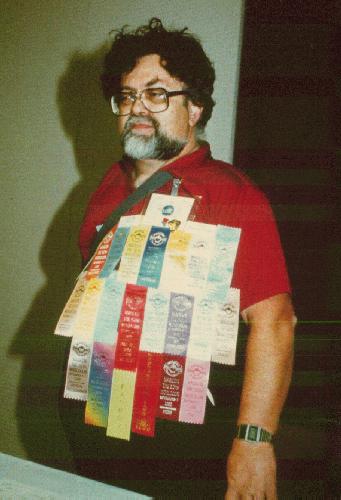
Bruce Pelz wearing his MagiCon ribbon collection.
CARPE PER DIEM: Thursday before the meet-the-pros, Elst Weinstein led two carloads of us to a Orlando shopping mall containing half a dozen upscale restaurants. We selected the Phoenikian, specializing in North African and Middle East cuisine.
Elst is a fascinating and dangerous dinner companion: since cooking exotic food is his passion he can advise and entertain about practically anything on the menu. But being Elst — once he has his dinner companions’ confidence he can’t resist a little put-on. The first time he got some fans in an Iranian restaurant he ultimately persuaded them into making finger sandwiches from the pita bread and all the condiments at the table: butter, chopped onion, chopped mint leaves and yogurt sauce. Now I believe if Elst went to dinner with six fans who had never been inside an American restaurant before, after he enthralled them with the legend of Worcestershire sauce and cellophane-wrapped crackers he’d probably instruct his slackjawed audience how to concoct an appetizer with the lemon-scented fingerbowl water…
RECURRING NIGHTMARES — MEET THE VIPS: Our dinner group arrived in the middle of Thursday night’s frantic “Meet the VIP’s” reception in the Clarion ballroom. As Richard Brandt said in next morning’s newzine, “In the dim, cavernous hall I was jotting down notes…pressed up against a far wall when a functionary with an Events gizmo came trotting over and demanded who had raised the lights. ‘You’re backing up against the dimmer switch,’ he told me. ‘Nobody touches the dimmer switch.’ ‘Heavens forfend,’ I replied, straining my eyes to see if I could recognize my date. I think she had stepped outside for some light.”
Crowds of party-dressed people were roaring to be heard above Mike Resnick, who was announcing Magicon notables over the public address while maybe three people in the room actually paid attention. As guests’ index cards were handed to him Resnick read their two-line bios; the three people paying attention looked around expecting the people Resnick was introducing to be spotlighted, or wave, or at least be in the room. No such luck. The meaningless recitation was painfully reminiscent of Shari Tepper’s depiction in Grass of believers’ names given a ritual utterance by a recorder at the universal church.
In “Xenogenesis” Harlan Ellison proved that from time to time fans do awful things to pros. What was done to Resnick belongs on the list. Sought after to emcee events like meet-the-pros, the Hugos (at NOLAcon) and the masquerade (at Chicon V), Mike Resnick has excellent stage presence, a wonderful announcing voice, good stories, and he’s easy for a committee to work with. How many more times Resnick will say “yes” is a question after he’s repeatedly had to salvage events from the mistakes of their organizers. I respect his loyalty, for no one’s patience is inexhaustible!
Indeed, the whole “meet-the-pros” concept proved unworkable long before I began attending Worldcons. Wrote Walt Willis in 1952 to those absent from Chicon I’s opening ceremonies: “[T]he only spectacles they missed were those of Erle (‘I cannot see’) Korshak as he peered despairingly about the vast auditorium looking for familiar faces to introduce. The Convention Hall was actually a huge terraced restaurant, with tier after tier of small tables rising in semi-circles from a large stage. One result of this was that even those who were within a stone’s throw of the official programme tended to ignore it as if it were a sort of cabaret.”
The “Platonic ideal” meet-the-pros reception allows fans easy access to the writers they want to meet, gives newcomers the means to match pros’ names to their faces, while it provides the pros comfortable surroundings.
But Worldcons are no closer to this achievement today than they were in 1952. The less-known guests reluctantly attend, anxious about an introduction to a blank-faced audience. Some experienced pros stay away for the very reason they will be recognized and overwhelmed by more fans than they can hope to converse with. Newcomers waiting for a particular favorite cannot enjoy a party while they are concentrating on a succession of introductions, and veteran fans, knowing the futility, get on with their noisy party and make it impossible for those actually listening. These psychological constants assure no amount of tweaking and revamping will ever make the “meet-the-pros party” into a successful Worldcon concept.
Several regional conventions have abandoned the concept without anyone noticing because they have kept the name. But “meet-the-pros” means two extremely different things at Armadillocon and BayCon. At Armadillocon everyone gathers into the biggest program room on Friday night and listens while a humorous pro like Shiner, Cadigan, Snodgrass or Connie Willis cracks jokes about friends in the audience: it’s great stand-up comedy and makes no pretense of giving systematic coverage of the guests. In contrast, BayCon is completely systematic, stationing guests at tables on the perimeter of a ballroom and having fans circulate among them in a glorified autograph party. (The number of guests and attendees at a Worldcon probably rules out adopting BayCon’s model, as would the amount of regimentation, which might alienate some well-known pros.)
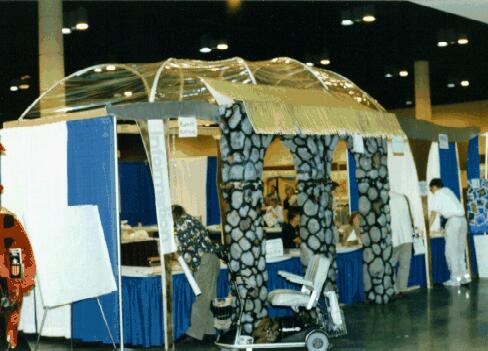
Art Show Print Shop. Photo by Carol Porter
ART SHOW: MagiCon’s “meet-the-pros” made a worrisome first impression, but did not prove typical of the committee’s planning or awareness of people’s needs. Only an hour later I was both grateful and impressed about Thursday night’s Art Show preview for MagiCon staff. This year no worker needed to say he or she was too busy working the con to see the Art Show
At the staff preview, as he did throughout the weekend, Vincent Di Fate guided fans through an extensive exhibit of his collection of historic science fiction art, giving his insights on each artist’s technique and impact on the field.
[Continued: Worldcon Wayback Machine: Friday at MagiCon (1992) Day Two.]

Vincent DiFate


